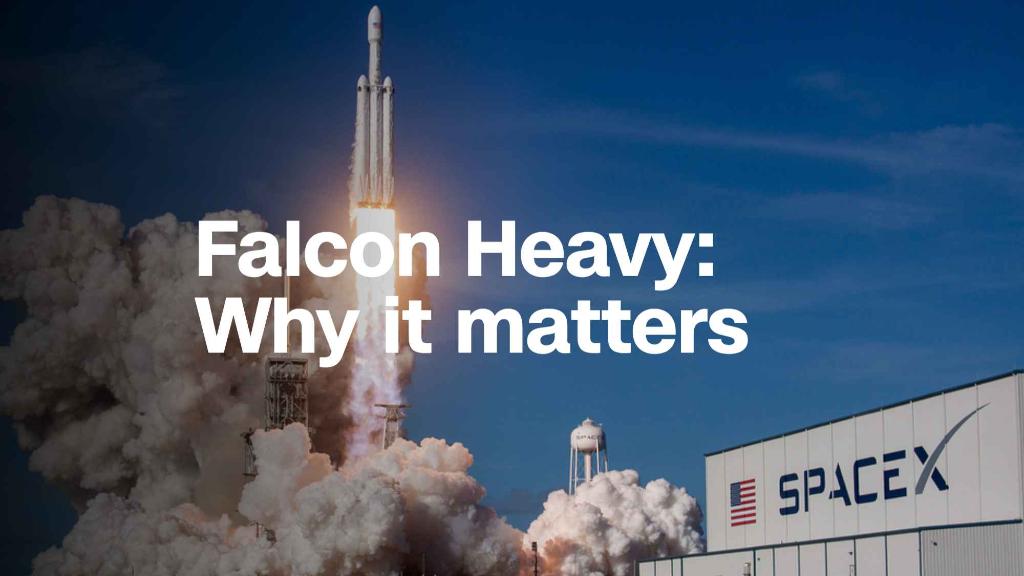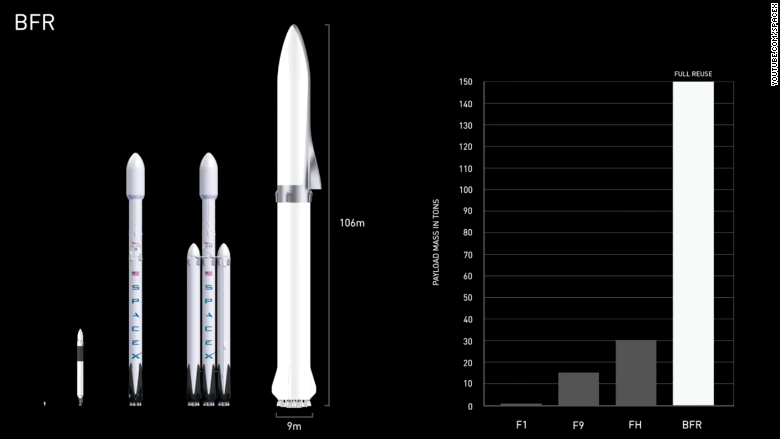
You just launched one of the most powerful rockets humans have ever built. So what do you do for an encore?
If you're Elon Musk, you up the ante. Big time.
The billionaire CEO of SpaceX hosted a press conference after the company's Falcon Heavy rocket aced its first launch Tuesday.
The new rocket is slated to fly a hefty telecommunications satellite for Arabsat, a Saudi Arabia-based firm, during the first half of 2018. It's also signed up to deliver a payload for the U.S. Air Force sometime this year.
But Musk was more interested in talking about what SpaceX will build next.
And he made it clear the company is still focused on its ultimate goal: Sending humans to live on Mars.
Falcon Heavy is big, he said, but SpaceX needs a rocket "way bigger than that."
SpaceX's idea of exactly how it will get humans to Mars has evolved over the years.
Musk revealed his most recent plan at a conference in Australia last year. It involves a truly enormous launch vehicle, called BFR or Big Falcon Rocket, that would give off more than 11 million pounds of thrust at liftoff. That's more than double the Falcon Heavy's thrust.
BFR needs enough power to vault a 160-foot long spacecraft (loaded with humans and all their cargo) into space before it can begin the months-long trek to Mars.

One of Musk's key takeaways from the Falcon Heavy's successful flight?
"It's giving me a lot of confidence we can make the BFR design work," he said.
Related: SpaceX launches Falcon Heavy, the world's most powerful rocket
In the near future, "most of our engineering resources will be dedicated to BFR, and I think that will make things go quite quickly," he said. A first test flight for BFR could happen in "three or four years."
SpaceX -- and the space community in general -- is notoriously loose with deadlines. When Falcon Heavy was first announced back in 2011, Musk said it could fly within the next couple of years. It ended up taking nearly seven.
And SpaceX does have one more thing to check off its to-do list before it can focus on BFR.
Related: You probably made more than Elon Musk last year
The company is developing a spacecraft that can fly humans -- a first for the company -- into orbit. It's called Crew Dragon, and NASA plans to use it to ferry astronauts to and from the International Space Station.
The United States hasn't had a spacecraft capable of sending humans to orbit since NASA's Space Shuttle program retired in 2011. Since then, the agency has relied on Russian spacecraft.
In 2014, NASA turned to the private sector for help. It awarded contracts to SpaceX and Boeing (BA) -- worth a combined $6.8 billion -- to develop systems that can transport astronauts. The goal was to end its reliance on Russia in 2017.
Obviously, that didn't happen. Both SpaceX and Boeing faced delays.
But Musk said Tuesday that he's planning to hit NASA's latest target of launching astronauts on Crew Dragon by December.
So, for now, "it's all hands on deck for Crew Dragon," Musk said. "That's our goal."
Crew Dragon will launch on a Falcon 9, the rocket SpaceX has flown since 2010.
Related: How Falcon Heavy stacks up with other massive rockets
But that doesn't mean Falcon Heavy will become a distant memory.
Musk said the rocket -- which is more than twice as powerful as any other rocket on the market -- is ready to launch whatever SpaceX clients can dream up.
"It can launch payloads straight to Pluto and beyond...it can launch giant satellites," Musk said Tuesday. It "opens up a new class of payload."
SpaceX does not, however, plan to certify the Falcon Heavy to fly humans. The company said in February last year that the rocket would send two people on a trip around the moon, but Musk said there's been a change of plans.
"I think the new architecture, the BFR architecture, is the way to go," he said.
-- Jethro Mullen contributed to this report.

